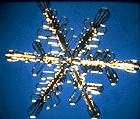Particles
Ice crystals form in the atmosphere when water freezes
onto tiny particles. Common sources of these particles are dust, volcanoes,
factory smoke, forest fires, and salt from ocean spray. The ice crystals
begin to grow around the particles, called "cloud condensation nuclei"
(CCN). The CCN may be as small as one millionth of a meter in diameter
and one trillionth of a gram in mass!
Question: If you have a pencil that uses lead that is
.5 mm thick, how many of these particles (CCN) could be lined up side by
side across the width of the lead?
Click here to see the answer.
| Snowflakes begin when water molecules freeze onto a particle.
Particles provide a place for the water molecules to "organize"
and form a crystal. Crystallized water is known as "ice."
Snowflakes grow when several ice crystals stick together.
They fall slowly through a cloud and grow by several processes as they
fall. Water vapor can freeze directly onto the surface of an ice crystal.
Or, flakes can grow by "riming," where liquid cloud drops collide
with an ice particle and freeze onto the crystal. Also, multiple individual
ice crystals can collide and stick together to form a larger snowflake.
You have probably heard every snowflake is unique. The
exact form of a snowflake is determined by its path though a cloud. Each
snowflake's path is unique and its final form tells the story of its journey.
|



|
Return to the page Where Did The
Moisture That Turned Into Snow Come From?





